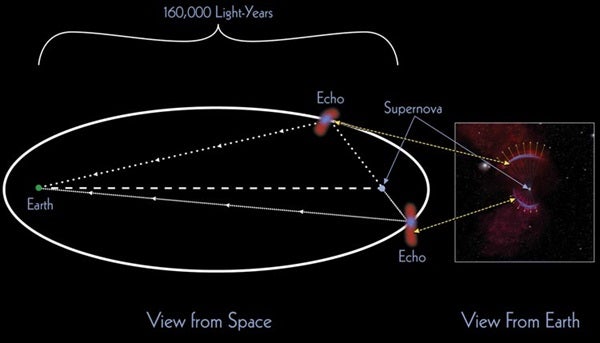Recently discovered light echoes can be traced back to three ancient supernova remnants in the Large Magellanic Cloud (LMC), say astronomers. Interstellar dust clouds reflect the centuries-old streaks of dim light. A research team at the Cerro Tololo Inter-American Observatory in northern Chile collected the light during the SuperMACHO wide-field sky survey while searching for evidence of dark matter. Their findings appear in the December 22, 2005, issue of Nature.
A supernova is a rare event that occurs about every 30 years in galaxies like the Milky Way, estimates a team of Lawrence Berkeley National Laboratory researchers that carried out the 1992 LBL Automated Supernova Search. Only two nearby supernovae have been visible to the naked eye in the last 400 years: one in our Milky Way Galaxy in 1604 and one in the Large Magellanic Cloud in 1987. A type 1a supernova — a 1.4-solar-mass white-dwarf star that is obliterated in a thermonuclear explosion — easily outshines an entire galaxy of stars for a month or longer. The cataclysmic event spews forth heavy-element particles in an expanding shell of gas and dust.
Sound echoes and light echoes are geometrically similar. A sound-wave echo results when sound waves reflect off a distant surface back to a listener. Similarly, light echoes are light waves traveling through space that reflect off interstellar dust toward an observer.
Unlike light waves absorbed and re-radiated by a dust cloud, light waves reflected as arc-shaped echoes retain the original light waves’ spectral distributions. Light echoes’ spectra tell astronomers much about the supernova that created them such as their location, age, and type.
Astronomers performed an image analysis on their survey data and matched the discovered light echoes to three young LMC supernova remnants. They estimate the ages of two of the remnants as 610 and 410 years, based on an examination of the light echoes’ proper motions. The astronomers also conclude the three remnants are type 1a based on the light echoes’ well-defined position origins and previous X-ray emission spectra taken with the orbiting Chandra X-ray Observatory. That’s a lot of information within the spectra of a few echoes of light.
Because the mass and brightness of a type 1a supernova are predictable, these death-throe events provide the basis for a universal “standard candle,” an object of known brightness with which to infer its parent galaxy’s distance. Heavy-element particles are a necessary element of star formation. Type 1a supernovae produce all the particles heavier than helium. Light echoes from a type 1a supernova provide a means of better understanding supernova events and how they shape the universe.










